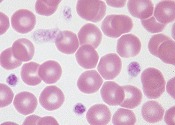Platelet Estimate
"Plat smear" represents a subjective estimation of platelet numbers made during
 Platelets dispersed in the "red cell area" of a canine blood film.
Platelets dispersed in the "red cell area" of a canine blood film.
|
examination of the stained blood film. As a rule no attempt is made
to provide an actual number, but rather a designation into categories
of "increased" (above reference intervals), "adequate"
(within reference intervals), "low?" (within low normal
limits or mildly decreased), "low" (below reference intervals),
and "very low" (< 30,000/µL) is made . For more precise
enumeration, a platelet count should be requested.
The estimate is made by counting the average number of platelets seen
per oil immersion field (in the "red cell area" of the smear"). This
number multiplied by 15,000 equals the approximate platelet count. For
example, if an average field contains 7 platelets, an estimate of 105,000/ÁL
would be appropriate. This value would then be compared to the normal
range for the species in question ... 105K would be "low" for a dog,
but "adeq" for a horse.
Smear estimates are performed on all samples in which a platelet count
is provided in order to verify the platelet count obtained manually
or from the hematology analyzer.
Often, a useful judgement about platelet adequacy can be made in this
manner even if platelets are too clumped to allow an actual count by
manual or automated methods. In some cases, with severe platelet clumping,
a platelet estimate cannot be provided.
Last Updated: June 2000
|